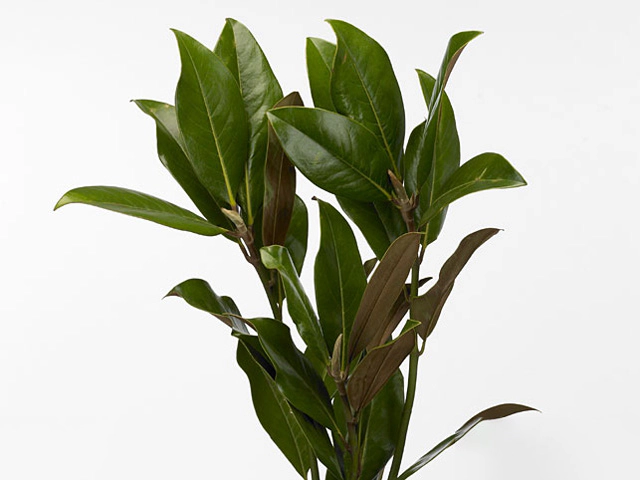Magnolia grandiflora per bunch

| Leaf margin | Entire |
| Leaf type | Foliage leaf |
| Winter hardness | Limited (USDA-zone 8) |
| Leaf, general shape | Ovate (egg-shaped); Elongate |
| Inflorescence | Few-flowered |
| Leaf duration | Evergreen |
| Leaf size | 15 - 20 cm; 10 - 15 cm |
| soil pH requirement | Slightly acidic (pH 4,5 - 6,5); Neutral (pH 6,5 - 7,5) |
| Light conditions | Sunny |
| Leaf division | Simple |
| Plant, growth type | Erect |
| Flower sex (distribution) | Monoecious (flowers bisexual) |
| Leaf, main color | Dark green |
| Toxicity (if consumed) | Not or barely |
| Moisture requirements | Moist; Well-drained |
| Soil type | Humus rich |
Magnolia grandiflora, commonly known as the Magnolia, is a majestic and beautiful tree that belongs to the Magnoliaceae family. It is characterized by its large, pristine white, fragrant flowers and its glossy, dark green foliage. Let's take a closer look at the various characteristics and requirements of this stunning tree.
One of the key features of Magnolia grandiflora is its evergreen nature. Unlike many other trees that shed their leaves during the fall, the Magnolia retains its foliage throughout the year. The leaves are ovate in shape, resembling an egg, and can grow to be 15 to 20 cm long and 10 to 15 cm wide. They have a smooth, entire margin, meaning that the edges of the leaves are undivided.
The Magnolia grandiflora thrives in sunny locations, requiring ample sunlight for optimal growth and blooming. It prefers slightly acidic to neutral soil, with pH levels ranging from 4.5 to 7.5. This tree also has specific moisture requirements, needing a moist but well-drained soil. Additionally, it prefers soil that is humus-rich, providing the necessary nutrients for healthy growth.
In terms of winter hardiness, the Magnolia grandiflora is limited to USDA zone 8. This means that it can withstand temperatures as low as 10 to 20 degrees Fahrenheit (-6 to -12 degrees Celsius). Therefore, it is not suitable for regions with extremely cold winters.
The Magnolia grandiflora produces few-flowered inflorescences, meaning that the flowers are clustered in small groups. These flowers are monoecious, which means that they contain both male and female reproductive organs. The flowers are bisexual and are known for their exquisite beauty and fragrant scent. They are often used in flower arrangements and can add a touch of elegance to any garden.
Although the Magnolia grandiflora is considered a safe tree, it is important to note that all parts of the plant, including the flowers and leaves, may contain toxins. While it is not highly toxic, it is advisable to avoid consuming any parts of the tree.
In conclusion, Magnolia grandiflora is a striking tree with its large, fragrant flowers and glossy, dark green foliage. It thrives in sunny locations with slightly acidic to neutral soil and requires a moisture-rich, well-drained soil. Its evergreen nature and limited winter hardiness make it a perfect addition to gardens in USDA zone 8. With its beautiful flowers and elegant appearance, the Magnolia grandiflora is undoubtedly a tree that will bring joy and beauty to any landscape.
Market availability index by month:
| Jan. | Feb. | Mar. | Apr. | May | Jun. | Jul. | Aug. | Sep. | Oct. | Nov. | Dec. |
|---|---|---|---|---|---|---|---|---|---|---|---|
| 4 | 3 | 3 | 1 | 1 | - | - | 1 | 1 | 2 | 3 | 3 |